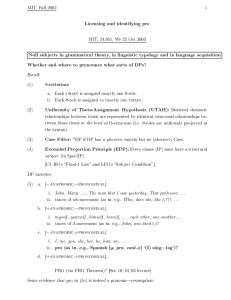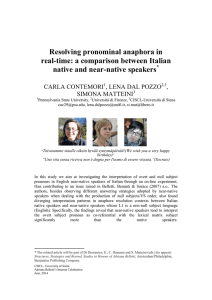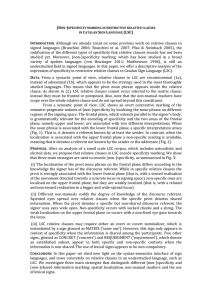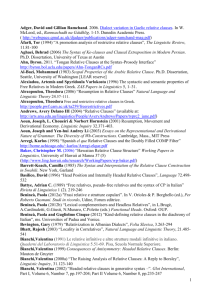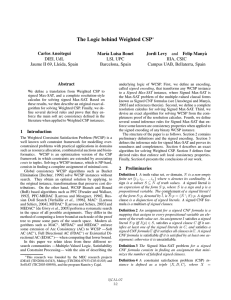On the nature of relative complementizers
advertisement
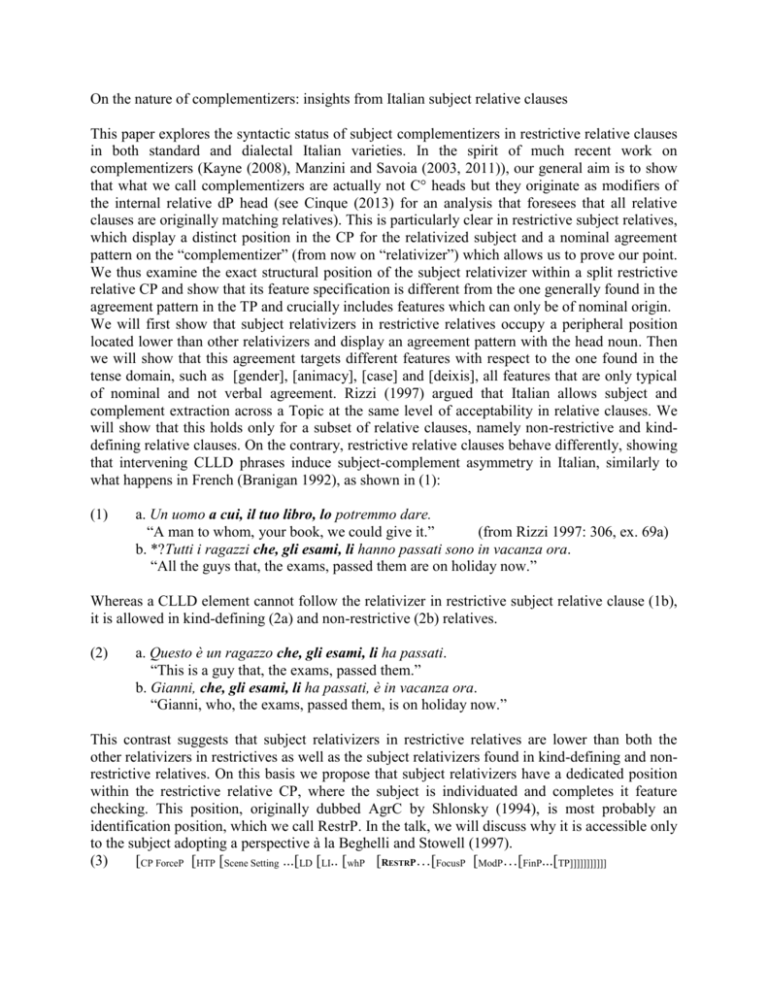
On the nature of complementizers: insights from Italian subject relative clauses This paper explores the syntactic status of subject complementizers in restrictive relative clauses in both standard and dialectal Italian varieties. In the spirit of much recent work on complementizers (Kayne (2008), Manzini and Savoia (2003, 2011)), our general aim is to show that what we call complementizers are actually not C° heads but they originate as modifiers of the internal relative dP head (see Cinque (2013) for an analysis that foresees that all relative clauses are originally matching relatives). This is particularly clear in restrictive subject relatives, which display a distinct position in the CP for the relativized subject and a nominal agreement pattern on the “complementizer” (from now on “relativizer”) which allows us to prove our point. We thus examine the exact structural position of the subject relativizer within a split restrictive relative CP and show that its feature specification is different from the one generally found in the agreement pattern in the TP and crucially includes features which can only be of nominal origin. We will first show that subject relativizers in restrictive relatives occupy a peripheral position located lower than other relativizers and display an agreement pattern with the head noun. Then we will show that this agreement targets different features with respect to the one found in the tense domain, such as [gender], [animacy], [case] and [deixis], all features that are only typical of nominal and not verbal agreement. Rizzi (1997) argued that Italian allows subject and complement extraction across a Topic at the same level of acceptability in relative clauses. We will show that this holds only for a subset of relative clauses, namely non-restrictive and kinddefining relative clauses. On the contrary, restrictive relative clauses behave differently, showing that intervening CLLD phrases induce subject-complement asymmetry in Italian, similarly to what happens in French (Branigan 1992), as shown in (1): (1) a. Un uomo a cui, il tuo libro, lo potremmo dare. “A man to whom, your book, we could give it.” (from Rizzi 1997: 306, ex. 69a) b. *?Tutti i ragazzi che, gli esami, li hanno passati sono in vacanza ora. “All the guys that, the exams, passed them are on holiday now.” Whereas a CLLD element cannot follow the relativizer in restrictive subject relative clause (1b), it is allowed in kind-defining (2a) and non-restrictive (2b) relatives. (2) a. Questo è un ragazzo che, gli esami, li ha passati. “This is a guy that, the exams, passed them.” b. Gianni, che, gli esami, li ha passati, è in vacanza ora. “Gianni, who, the exams, passed them, is on holiday now.” This contrast suggests that subject relativizers in restrictive relatives are lower than both the other relativizers in restrictives as well as the subject relativizers found in kind-defining and nonrestrictive relatives. On this basis we propose that subject relativizers have a dedicated position within the restrictive relative CP, where the subject is individuated and completes it feature checking. This position, originally dubbed AgrC by Shlonsky (1994), is most probably an identification position, which we call RestrP. In the talk, we will discuss why it is accessible only to the subject adopting a perspective à la Beghelli and Stowell (1997). (3) [CP ForceP [HTP [Scene Setting ...[LD [LI.. [whP [RESTRP…[FocusP [ModP…[FinP...[TP]]]]]]]]]]] This position is related to specific agreement patterns: several Italian varieties display a special relativizer for subject extraction whose morphology changes according to subject features like deixis, animacy, and gender, as Old Neapolitan, which displays chi with a masculine antecedent (4a) and che with a feminine one (4b). (4) a. uno romano chi se chamao Cornelio nepote de lo grande Salustio “A Roman that is named Cornelio, nephew of the great Sallustio […].” (LDT 47) b. considerate le cose maravegliose che nce foro facte e dicte “Considered the marvelous things that were made and said […].” (LDT 47) The fact that inside the CP layer there is a dedicated position where agreement with the subject is marked independently from the agreement relation between the subject and the verb inside TP reveals that “complementizers” are not complementizers at all. Furthermore, the nominal type of features specified on the relativizers suggests that relativizers are first merged as modifiers of the dP head, with whom they agree, and are then subextracted and reach the RestrP bringing their nominal agreement features with them. This idea will be further strengthened during the talk by a) the analysis of cases of non-subject extraction in dialects which use a distal agreeing demonstrative as the relativizer, as in (5), (5) L seniëur de chël che cunësci la sor röa enco the man of DEM:MASC REL know the sister arrives today “The man of whom I know the sister arrives today.” (San Vigilio di Marebbe) and b) the following empirical generalization: if a dialect does not use the form qual- as a whadjective, it will not display the form qual- as a relativizer. The generalization can only be explained by assuming that qual- is always an adjectival form, both in interrogatives and relatives and, when its adjectival use is not available, it does so in both interrogatives and relatives. The status of qual- as modifier is also suggested by the retention of the internal head in non-restrictive RCs as in (6) (from Cinque 1988: 449). (6) Giorgio riuscì a sposare quella ragazza. Della quale ragazza, devo dire, ero invaghito anche io. “Giorgio managed to marry that girl. Which girl, I must say, I was also in love with.” Hence, our findings on “inflected complementizers” not only challenge the standard dichotomy between complementizers and relative pronouns as first proposed by Klima (1964) and Kayne (1975), suggesting that relativizers are in fact a kind of relative pronoun as recently stated in Manzini & Savoia (2003, 2011) and Kayne (2008), but go even further, since we do not claim that all relativizers, including our subject relativizers are pronouns, but that they are adjectives, i.e. they are originally merged with the internal head and then moved to the relative CP. Selected References: CINQUE G. (2013). Typological Studies. Word Order and Relative Clauses. New York/London: Routledge. •KAYNE R. (1975). French Syntax. Cambridge (Mass.): MIT Press. •KAYNE R. (2008). Antisymmetry and the lexicon. Linguistic Variation Yearbook. 8: 1-31. • MANZINI R. & L. SAVOIA (2011). Grammatical Categories. Cambridge: Cambridge University Press. •RIZZI L. (1997). The fine structure of the left periphery. In: HAEGEMAN L. (ed.). Elements of Grammar. Kluwer: Dordrecht. 281-337.
